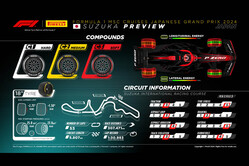[ad_1]

This 12 months, the Japanese Grand Prix takes place in April for the primary time in its historical past: proper as much as final 12 months the race was all the time scheduled for the second a part of the season, in September or October. In consequence, Suzuka has incessantly topped world champions – each within the drivers’ and producers’ standings. The final two years have been no exceptions: in 2022, Max Verstappen sealed his second title on the venue, whereas final 12 months Purple Bull have been topped constructors’ champions.
The fourth occasion of the season coincides with the height of the cherry blossom – or Sakura – season, between the top of March and starting of April. It is also the very first time that the Japanese Grand Prix will probably be held at the moment of 12 months: the primary Pacific Grand Prix came about at Aida on 17 April 1994, earlier than transferring to October in 1995. The early spring can even deliver decrease temperatures than the groups are used to in Japan, with common temperatures ranging between 8 levels C and 13 levels C.
Suzuka is a real traditional: the 5.807-kilometre Honda-owned monitor assessments each driver’s skills with a demanding structure characterised by a figure-eight structure, distinctive in Method 1.
Along with representing a rare problem for automobiles and drivers, the monitor additionally assessments the tyres: each by way of put on – resulting from excessive ranges of asphalt roughness and abrasiveness – in addition to by means of the forces and masses to which they’re subjected all through the number of corners that make up the lap. As traditional, Pirelli has chosen the toughest trio of compounds: C1 as laborious, C2 as medium and C3 as smooth. This is similar choice as was utilized in Bahrain for the primary race of the season.
A two-stopper is the commonest technique, as a result of power going by means of the tyres and the stress to which they’re subjected. Nonetheless, decrease temperatures may imply {that a} one-stop technique turns into doable, particularly for drivers who’re light on their tyres. Alternatively, this may make it more durable to maintain the tyres within the appropriate working window, notably when bringing them as much as temperature on an out-lap from the pits. A one-stopper additionally decreases the effectiveness of the undercut, which is often very helpful at Suzuka, even with the laborious and medium compounds being the popular race compounds.
After the Japanese Grand Prix there will probably be two days of Pirelli tyre testing on Tuesday 9 April and Wednesday 10 April with Stake F1 Workforce Kick Sauber and Visa Money App RB Method One Workforce, to develop constructions and compounds for subsequent season.
There have been 37 editions of the Japanese Grand Prix to this point, 33 of which have been held at Suzuka. The remaining 4 came about at Fuji monitor, which is owned by Toyota. Essentially the most profitable driver continues to be Michael Schumacher with six wins: the German additionally has probably the most pole positions (8) and podium finishes (9). When it comes to group achievements, McLaren has probably the most victories (9) whereas Ferrari has probably the most pole positions (10).
The Suzuka circuit has 18 corners, a few of which – reminiscent of Spoon, 130R and the uphill mixture between Turns 2 and seven – are among the many most well-known on the world championship calendar. Much less well-known are the 2 Degner corners, named after Ernest Degner, a German bike racer of the Nineteen Fifties and Nineteen Sixties.
Born in Gleiwitz (in Poland’s Silesian Highlands) in 1931 and raised in East Germany, Degner was one of the crucial outstanding sportsmen in Jap Europe. He raced MZ two-stroke bikes designed by Walter Kaaden: an excellent engineer who labored for the Nazis at Peenemunde throughout World Struggle II: the key weapons analysis facility commissioned by Adolf Hitler. Due to Kaaden’s creativity, the MZs have been in a position to beat not solely the established European competitors but additionally these of their rising rivals from Japan, who have been simply starting to make their identify.
In 1960, for instance, Suzuki entered worldwide competitors for the primary time however the Japanese bike was dramatically gradual, ending the 1960 Isle of Man TT a full quarter-hour behind the winner. It was clear that the Japanese agency urgently wanted exterior know-how, however the place to search out it? The reply got here within the type of an opportunity assembly that came about the next 12 months between Degner and firm president Shunzo Suzuki. Throughout their dialog, Degner mentioned he was bored with his boring life in East Germany, as the remainder of the world was beginning to emerge from post-war austerity: he had additionally had sufficient of the fixed surveillance from the Stasi – Germany’s secret police – who adopted him to each race.
The Stasi have been so involved that Degner may defect that his household weren’t allowed to return to race, in order that he would all the time have a motive to return residence. Naturally, Degner additionally hated the truth that most different riders – even these with far much less expertise – have been paid rather more than him, as underneath his residence regime he needed to accept a wage equal to nearly another MZ employee.
An settlement was rapidly reached: Degner would run away, assist Suzuki develop their bikes after which race for the Japanese. However he would not depart East Germany with out his household and, with the Berlin Wall having simply gone up, getting them out appeared virtually not possible.
So in the course of the 1961 Swedish Grand Prix weekend (which came about in Kristianstad) Degner organised his household’s escape, with the assistance of a pal from West Germany who made frequent enterprise journeys to East Berlin. The pal smuggled them out in a secret compartment within the boot of a Lincoln Mercury, with Degner counting on the truth that the Stasi spent extra time watching him at race weekends overseas than his household at residence.
He retired from the Swedish race resulting from engine failure after which fled to West Germany to reunite together with his household earlier than transferring to Hamamatsu, the place Suzuki’s headquarters have been situated. MZ instantly cancelled their abroad race programme, simply in case anybody else had the intense concept of following Degner’s instance…
Degner raced for Suzuki in 1962; regardless of residing in fixed worry of being killed by the Stasi, he nonetheless managed to win the primary world title within the 50cc class. However the dream become a nightmare the next 12 months. On the Japanese Grand Prix in Suzuka he fell from his bike within the place now referred to as the Degner Curves and, when the gasoline tank exploded, he suffered extreme burns requiring over 50 pores and skin grafts.
He returned to racing the next 12 months however was dogged by different accidents earlier than retiring for good in 1966. Dwelling with fixed ache brought on him to slide into morphine habit: his loss of life in 1983 aged simply 51 (when he was residing in Tenerife) was formally all the way down to a coronary heart assault, however many thought it was attributable to an overdose, whereas some folks believed that the Stasi lastly caught up with him.
In any case, Turns 8 and 9 of the Suzuka monitor are actually named after him as a tribute to his contribution to Japanese motorcycling historical past.
[ad_2]
Source link





















